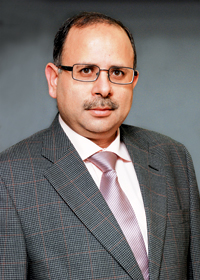 Sandeep Raina
Sandeep Raina
Senior Vice President – Govt & Defence
Cisco India & Saarc
Sandeep Raina, Senior Vice President, Cisco India and SAARC is an industry veteran with over 20 years of experience in the IT industry. In this freewheeling interview with Dr Ravi Gupta and Lakshmi Singh, he talked about the overall performance of e-Governance in the last seven years in India
What is your roadmap or vision on how e-Governance should evolve in India. What are the achievements of e-Governance in these seven years?
Technology when applied appropriately not only improves performance and lowers cost of government operations but also brings a paradigm shift in relationship between government and the people. Government agencies across the country have been experimenting with the use of ICT, first to improve their internal work and thereafter for improving service delivery but with varying degree of success. However, it is only with National eGovernance Plan (NeGP) that this area has got the right direction and the requisite focus in terms of common ICT infrastructure (SWAN/SDC/CSC) and detailed guidelines on e-Gov application. There have been failures and successes, time overruns, cost overruns but that is expected in a plan of such large magnitude, especially when programmes are being taken up for the first time by many states/UTs, which are at different levels of ICT development. While infrastructure has largely been put in place, development of application has been delayed, which needs to be accelerated. Cisco has always accorded high priority to the Government and public sector vertical and this will continue in the years to come. The company has a dedicated team to address the growing business needs of this sector. Cisco’s strategy has been to deliver the highest degree of operational excellence to governments, enabling them to make timely and accurate decisions and improve operational efficiency. Governments, world over, are under pressure to deliver services more efficiently and effectively that are focused on the needs of their constituents. IT systems are a critical foundation as governments seek to be more connected to citizens, business, partner agencies, and other governments.
Cisco solutions allow multiple departments to securely share infrastructure and services in order to drive greater service effectiveness and organisational productivity. To address the sector in India, Cisco is working with partners such as IBM, HCL, Wipro, Infosys to draw synergies in their applications being developed for governments. Some of the large projects that the company is involved in are the implementation of State Wide Area Network (SWAN) and State Data Center (SDC) creation. In addition to the on-going engagements with state and central government organisations in ICT infrastructure creation, Cisco is also working closely through its strategic consulting arm Internet Business Solutions Group (IBSG) with Department of Information Technology (DIT), National Institute of Urban Affairs, National Institute for Smart Government (NISG), Unique Identification Authority of India (UIDAI) and few State Governments. The IBSG helps Fortune 500 companies and leading public organisations across the world, improve the customer experience and increase revenue growth by transforming the way they do business. Drawing on a unique combination of industry experience, business acumen and technical knowledge, IBSG consultants work as trusted advisers to many of the world’s governments and leading organizations on pro-bono basis.
Recently Cisco has signed a memorandum of understanding (MoU) with CSC e-Governance Services India Ltd.The purpose of the MoU is to make education and healthcare solutions available to rural India and to promote social inclusion through CSCs.
What is the plan behind introducing legislation on electronic delivery of services (EDS)? How optimistic are you with this legislative framework, since achieving the same would have been challenging under NeGP? What has to be the new mission of the NeGPs?
In a broad perspective, the NeGP initiative owing to a vast outreach, with 27 Central Mission Mode Projects over a period of five years has progressed very well in our country. The most important thing that needs to be implemented is the review mechanism in the entire process. It is necessary to check if a particular model is working well in all the 27 departments across 35 States. With a review mechanism, we can analyze as to how we help them achieve a mission or how many mission modes are to be modified or how do we help them manage the infrastructure. Secondly, we must undergo a thorough research to analyze how many state mission modes have been successfully implemented? One must use cloud to replicate that. If a model works well in state, it is not necessary that all the 35 states should follow the same but there’s no harm in replicating best practices. A body needs to be constituted to review whether a particular model has been implemented successfully and analyze the feasibility and relevance for another state. Thirdly, accountability has to be done around all the projects. There is a need to show a substantial cost difference in terms of what a service would cost. A citizen may be happy to pay a slightly higher amount for a more efficient delivery of the service through ICT. However, that price difference cannot be significantly higher. Productivity gains have to be at the core of implementation while keeping customer delivery in mind. Ultimately it is the quality of service and the cost of implementation that are important. There is a need to divide the concept of e-Governance into lot of sub sectors
Be a part of Elets Collaborative Initiatives. Join Us for Upcoming Events and explore business opportunities. Like us on Facebook , connect with us on LinkedIn and follow us on Twitter, Instagram.











